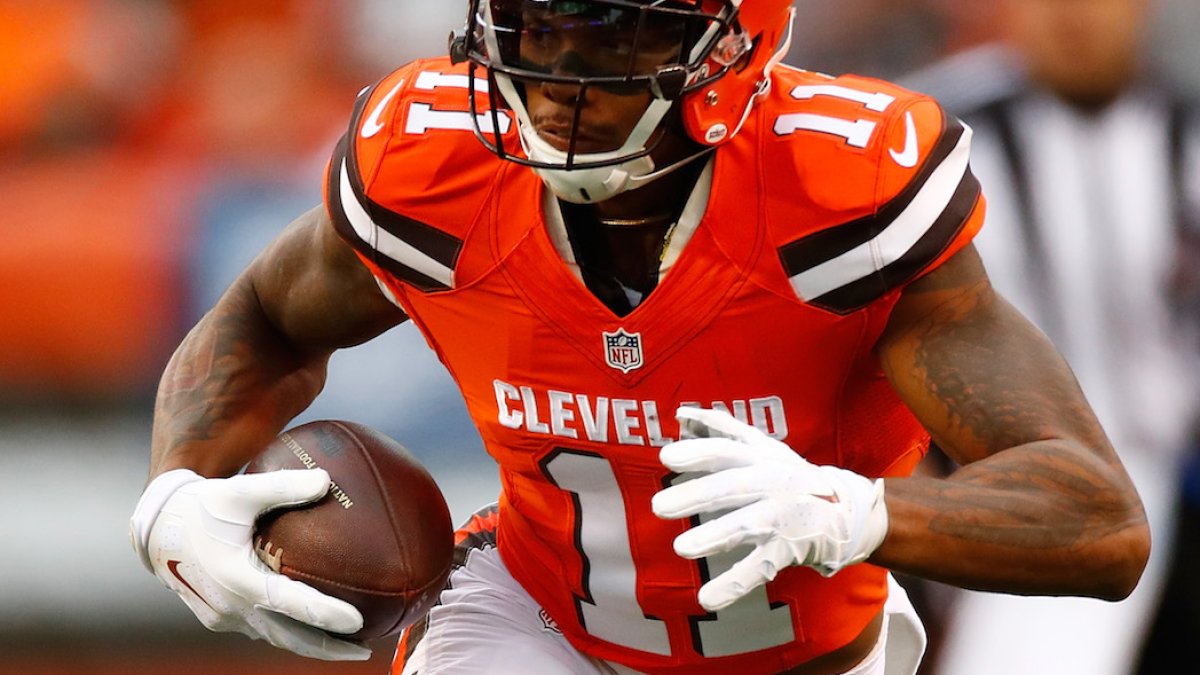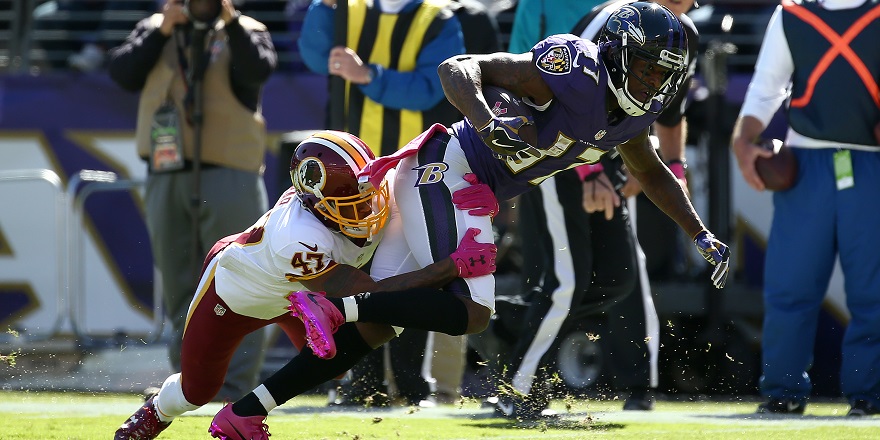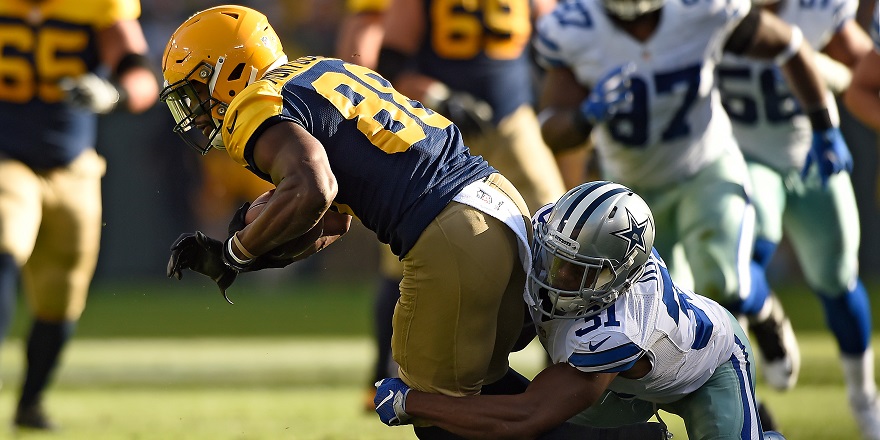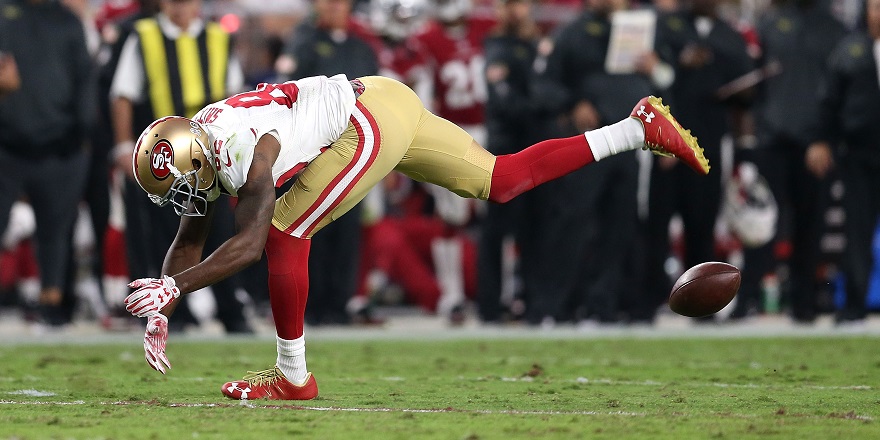Wednesday, in part one, we examined six teams with a truckload of combined unclaimed handoffs and PFF-charted targets from the 2016 season. Let’s now take a look at nine offenses with a significant number of one or the other, followed by a trio of teams with few unaccounted-for opportunities – and the resulting impact on their fantasy outlooks.
Baltimore Ravens
(Unclaimed: 212 targets)
Despite picking up Mike Wallace’s 2017 option and reworking Dennis Pitta’s contract, the Ravens have the league’s second-most unclaimed targets. Baltimore topped the NFL in pass attempts (679) despite leading on the ninth-highest percentage of snaps (40.1) and firing run-forsaking offensive coordinator Marc Trestman before Week 6. Talk is cheap, however, and the Ravens added pass-catching dynamo Danny Woodhead to a backfield missing 56 targets. Second-year running back Kenneth Dixon is suspended for the first four games, knocking the starch out of his price in all formats. He performed well last year, grading fourth-best of 152 qualifying backs in rushing grade on a per-attempt basis.
In addition to Wallace (109), Breshad Perriman (64) will almost certainly add to his 2016 target total following what was essentially a redshirt rookie season. Baltimore hasn’t yet added anyone to their pass-catching corps, making Chris Moore and slot man Michael Campanaro, in addition to their flock of tight ends, worth monitoring for depth-chart clues. One concern is the Ravens deployed four positively graded pass-blocking offensive linemen last season and only two of them remain on the roster. Joe Flacco’s 57.5 passer rating while under pressure ranked 25th last year – his best finish in the last four seasons.
Washington Redskins
(200 targets)
The Redskins have the third-most unclaimed targets, but because they all departed with Pierre Garcon and DeSean Jackson, Washington leads the league in wide receiver opportunity. Jamison Crowder already saw 92 targets, with 67 of them coming in the slot. He likely increases his 76-percent slot snap rate, adds a chunk of Jackson’s 21 slot targets, and comfortably clears the 100-target threshold. Free agent signee Terrelle Prior is unlikely to top his workload from last year (132 targets), but he can come close – and the quality of those throws is a mortal lock to rise.
Kirk Cousins finished third in PFF QB rating, with no Browns quarterback finishing better than 30th. He still needs to develop a rapport with 2016 first-round pick Josh Doctson, who missed all but 31 snaps last year. Doctson’s Achilles appears healthy judging from a video he posted of himself playing basketball last week. It may be a stretch to expect fantasy-viable production right away, but the opportunity will be there. With a heavy dose of unknown on the perimeter, pass-catching running back Chris Thompson (59 targets), along with tight ends Jordan Reed (85) and Vernon Davis (58), are more likely than not to see their workloads expand.
Oakland Raiders
(198 handoffs, 85 targets)
The Raiders’ 85 missing targets were spread fairly evenly across their running back (38), wide receiver (23) and tight end corps (24). Between Jalen Richard and DeAndre Washington – who combined for 61 targets and both sported above-average blocking grades – how those running back looks are distributed is a foggy projection. Oakland’s 198 unaccounted-for handoffs, however, are much more interesting and are tied with the Giants’ for second-most. The current assumption is the Raiders will import a veteran back. Adrian Peterson has been a rumored option despite owner Marc Davis’ zero-tolerance domestic violence policy, while on-hiatus Marshawn Lynch is somehow the odds-on favorite.
Lynch only averaged 1.2 yards before initial contact during his last year in Seattle, while Raiders running backs enjoyed 1.8 last season. We know what Lynch can do when he has a runway, as his 3.4 touches per forced-missed-tackle led all running backs in 2015. In fact, in each of his last three seasons (3.4, 3.1, and 3.9), Lynch bettered Jay Ajayi’s league-leading 4.6 average from last year. Whoever gets the lion’s share of those handoffs should run hot in last season’s fifth-best run-blocking offense, on an ascending team that figures to hold a lead more often than their 34.2-percent of snaps from 2016 (15th-most).
Green Bay Packers
(170 handoffs, 91 targets)
The Packers’ thinned-out backfield has the league’s fifth-most unaccounted-for handoffs. It consists of converted wideout Ty Montgomery, newly re-signed Christine Michael, and a pair of characters only Miami Vice aficionados can love – John Crockett and Don Jackson. Reinforcements will arrive in the form of a veteran, a draft pick, or both. Montgomery is currently affordable in MFL10 drafts (RB25, late-sixth round) and set for a workload bump after his first full offseason as a running back. He led all backs in yards after contact per attempt, ranked 10th in PPR scoring during the six weeks he received at least 50-percent of snaps, and his rushing grade ranked fifth-best of 88 qualifying running backs on a per-attempt basis.
Montgomery should also see some of the Packers’ 34 departed running back targets – especially if Adrian Peterson is signed – with the remaining 50-odd unclaimed looks funneling toward tight end. Jared Cook finally had a good hand and overplayed it, allowing Martellus Bennett to step into his 50 targets. Packers’ tight ends don’t typically move the fantasy needle on a consistent basis, however, and Bennett is risky if treated as more than a low-end fantasy TE1. Aaron Rodgers took 87 more dropbacks last year than in his next-highest season, a repeat of which is unlikely — even if it was both effective and fun to watch.
Buffalo Bills
(164 targets)
The Bills quietly have the fourth-most unclaimed targets, with the majority coming at wide receiver (143). When we consider they threw the NFL’s fewest passes last year, even more could be on tap. Rex Ryan left town with his “ground-and-pound” mandate and Bills-themed pickup truck. While Buffalo’s bread-and-butter remains their running game, new offensive coordinator Rick Dennison’s teams have finished middle-of-the-pack or higher in pass attempts each of the last five seasons, and Buffalo has nowhere to go but up.
The Bills wisely held onto Tyrod Taylor, fantasy’s seventh- and ninth-highest-scoring quarterback the last two seasons, respectively (currently with a QB18 MFL10 ADP), although their receiver depth chart is basically “Sammy Watkins and pray.” Former Raider and fantasy-Twitter darling Andre Holmes, as well as former Panther Corey Brown, currently slot under Watkins on the depth chart, but expect draft-day reinforcements. Charles Clay saw 81 targets last year, 13th among tight ends, and could see additional looks. Either way, the passing game is full of opportunity, and the depth chart is still written in pencil.
Carolina Panthers
(149 targets)
The Panthers’ 134 unaccounted-for wide receiver targets rank as the sixth-most, and their 149 total unclaimed targets are the ninth-most – which at last year’s rate would only be about 79 completions for Cam Newton. Never a high-percentage passer, Newton’s upcoming rotator cuff surgery puts a slight damper on 2017 expectations for Kelvin Benjamin and Devin Funchess. Rarely on the same page last season, Newton loses a chance to build rapport with his top wideouts – not to mention free-agent imports Charles Johnson and Russell Shepard — until training camp, at the earliest.
With Carolina projected to add a pass-catcher or two in the draft, the quarterback’s most trusted weapon will again be tight end Greg Olsen, who has little room to add onto his 122 looks. Benjamin and trendy breakout candidate Funchess have the most to gain from the glut of available receiver looks, but the degree of difficulty grows with Newton’s surgery. While Benjamin had a disappointing fantasy season, his game grew as the season went along – receiving only four below-average grades in 16 games. Funchess’ passing game grade ranked 71st out of 119 qualifying wideouts, and while he is currently dirt-cheap in drafts, he remains a work in progress.
Tennessee Titans
(74 targets)
The Titans fall in the bottom half of the league in terms of unaccounted-for targets, and only the Falcons lost fewer handoffs. Rishard Matthews, Tajae Sharpe, and if you squint hard enough, Tre McBride are the wideouts of note on the current roster — with all due respect to both Harry Douglas fans. The assumption is they draft a wideout early, perhaps with one of their two first round picks. Even if they do, few receivers step into No. 1 wideout status early in their rookie seasons – and there’s no guarantee general manager Jon Robinson drafts one in the first round.
Robinson comes from New England, where they’ve never picked a first-round receiver under Bill Belichick and have only taken four in 23 second-round picks – with just one coming in the last decade. Matthews will remain their most-targeted wideout, at least to start the season. After he began getting full snaps in Week 8, Matthews was the fantasy WR8, tied for eighth in points-per-opportunity, and averaged 8.3 targets per game – more than Delanie Walker (6.4) and DeMarco Murray (4.0) saw last year. Those targets aren’t going away, and Marcus Mariota is only getting better.
Philadelphia Eagles
(24 targets)
The Eagles ranked third in plays per game (67.5). The other 31 teams averaged 315 more throws after Week 8, while the Eagles threw a league-high 397. Philadelphia trailed on 52.3 percent of their offensive snaps, the league’s 10th highest rate. Even with the mercurial Dorial Green-Beckham and Nelson Agholor — our worst-graded wideout for two straight seasons – slated for fewer than last year’s 129 combined targets, there will be an overall opportunity pinch. Only the Texans and Chiefs have fewer unaccounted-for targets slated for 2017 redistribution.
Alshon Jeffery and Torrey Smith are enormous perimeter receiving upgrades for the Eagles and will need to be fed accordingly. Jordan Matthews’ 109 targets were less than he saw in 2015 (120), but his per-game rate has grown each season, from 6.1 as a rookie, to 7.5, and 7.8 in 2016. The trend may end, but Matthews will still see a healthy total while working the slot. While Zach Ertz led all tight ends in targets and fantasy scoring after Week 8, he ranked 21st in points-per-target. It was a volume-driven performance and, with the Eagles’ dearth of unclaimed targets and improved supporting cast, Ertz’s 2017 outlook is written on a red flag.
Kansas City Chiefs
(8 targets)
The Chiefs have the league’s fewest total unclaimed opportunities from last season (37), and that’s a problem for fantasy. Jamaal Charles is gone, but he only touched the ball 14 times. Jeremy Maclin played the fewest snaps (681) and ran the fewest routes (439) of his career, aside from his lost 2013 season. He will command more opportunities. Travis Kelce’s 121 targets were a career high. Tyreek Hill’s playing time picked up during the second half and will supposedly continue growing – but where are the opportunities coming from?
Spencer Ware is being drafted in the early fourth round of MFL10s (RB18) and finished as the PPR RB16 last season. Looks pretty fair. Yet, he derived over 45 percent of his points in the passing game, with over 37 percent of those passing game points coming in Week 1 and Week 7. He had only three games with more than three targets. Relying on the same production carrying over is like banking on C.J. Spiller’s Kansas City revival. The Chiefs have run the 27th-, 31st-, and 29th-most plays over the last three years. This remains an offense with little explosive capability or available opportunity.






 © 2025 PFF - all rights reserved.
© 2025 PFF - all rights reserved.